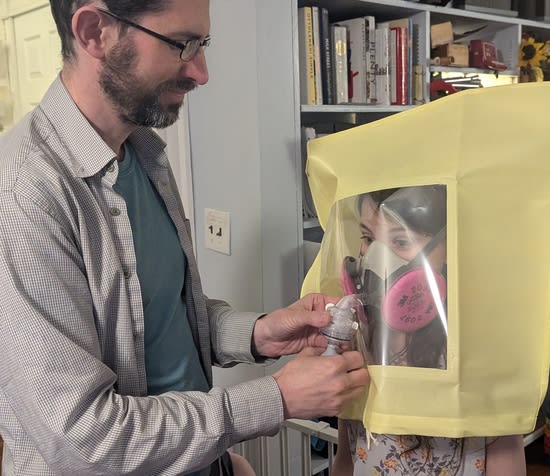Published on May 23, 2025 2:50 AM GMT
As I wrote about lastweek, it's worth it for everyone to have an elastomeric respiratorin case of emergencies: the chance of a severe pandemic is high enoughthat even under reasonably conservative assumptions the return oninvestment is ~10x. Because not every mask fits every face and apoorly fitting mask will leak air around the seal—it doesn'tmatter how good the filters are if they're bypassed—it's good totry on a range and see what's good. I invited some people over to tryout a range of masks and play with fit testing.
There are a range of ways to see if a mask fits. A good first test isto put it on and see if you feel air leaking around it. If it'spossible to cover the intake you can breath in while wearing it, andyou should feel it pull tight against your face. These tests areoften enough to rule out masks, and are pretty quick.
Once you've identified a mask you think is plausibly a good fit youcan do qualitative fit testing. The idea is, you make some particleswith a strong taste or smell, and see how well they can get in whileyou're wearing the mask. If they can't get in, especially as you moveyour head around, talk, and grimace, then your seal is pretty good. Igot a kit (GersonQLFT50M) which included several components:
A hood the test subject wears over their head, so you don'tneed to fill the whole room with particles.
Saccharin (sweet) or Bitrex (bitter) solution, which have astrong taste you should notice clearly if it makes it through themask.
A squeeze-bulb nebulizer, to turn the strong-tasting liquidinto tiny strong-tasting particles.
You put the liquid in the nebulizer, poke the nebulizer through a holeconveniently provided in the front of the hood, and squeeze outparticles.
One key thing about the setup is there are two solutions and twonebulizers. One is the weaker sensitivity solution, which you breathemaskless to ensure you can detect the test particles, and the other isa stronger [1] test solution, which ideally doesn't make it throughthe mask in detectable quantities.
While this seems to be a common design, I really don't like how itrelies on the two nebulizers performing identically. Especially sinceinitially mine didn't: the sensitivity testing nebulizer worked great(easy to squeeze, you can see the little bubbles going, fine mist)while the fit testing nebulizer worked much less well (harder tosqueeze, needed more adjustment, much less little bubble movement, lessmist). After people went home I played with the nebulizers and got abetter feel for how to adjust them to get them both performing well.This would have been good to do before!
I'm planning to bring the masks and test kit to LessOnline, which I expect to beenriched for people who would be interested in this sort of thing.
[1] You use a muchlarger difference for saccharin (100x in the fit test) than Bitrex(12.5x). I'm still confused about this, but some asking Geminisuggests it's because "the 'low, but generally detectable'concentration and the 'significantly stronger, but not unbearable'concentration are vastly different relative to each other for thesetwo substances due to their intrinsic taste properties."
Discuss


